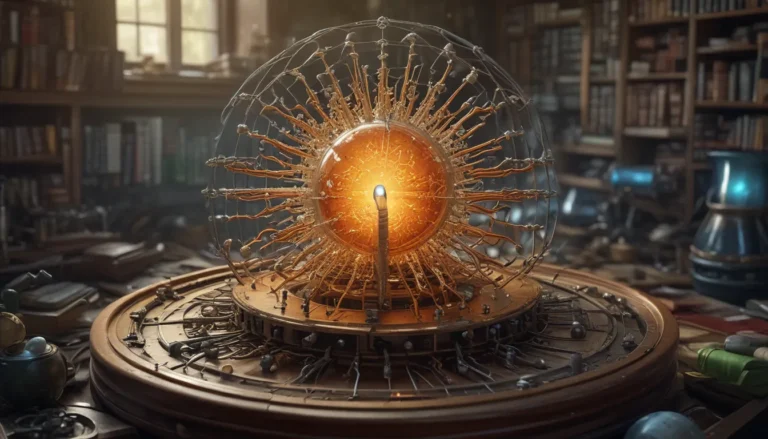A Note About Images: The images used in our articles are for illustration purposes only and may not exactly match the content. They are meant to engage readers, but the text should be relied upon for accurate information.
Physics enthusiasts and students alike are captivated by the intriguing phenomenon known as Rutherford scattering. Named after the renowned physicist Ernest Rutherford, this concept provides valuable insights into the intricate structure of atoms and the fundamental nature of matter. In this comprehensive guide, we will explore 19 fascinating facts about Rutherford scattering, shedding light on its significance, the experimental setup, and the remarkable discoveries made during its exploration.
Key Takeaways
- Rutherford Scattering, discovered by Ernest Rutherford, revolutionized our understanding of atomic structure and paved the way for modern physics research and advancements in nuclear energy.
- Rutherford’s groundbreaking experiments led to the discovery of the nucleus, protons, and neutrons, inspiring future scientists and shaping our understanding of the atomic world.
The Groundbreaking Experiment
Ernest Rutherford and his colleagues conducted a groundbreaking experiment in 1909, leading to the discovery of Rutherford scattering. This pivotal experiment marked a turning point in the field of physics, challenging existing theories and revolutionizing the understanding of atomic structure.
Challenging the Plum Pudding Model
Prior to Rutherford’s experiment, the prevailing model of the atom was the “Plum Pudding Model.” Rutherford’s findings not only debunked this model but also unveiled the flaws in the existing understanding of atomic composition, setting the stage for a new era of scientific exploration.
The Unexpected Results
During the experiment, Rutherford bombarded a thin gold foil with alpha particles, expecting them to pass through the foil or be slightly deflected. However, he was in for a surprise when a small fraction of the particles were deflected at large angles, and some even bounced back. These unexpected results defied classical physics and opened up a realm of new possibilities in atomic research.
The Nuclear Model of the Atom
Rutherford’s observations paved the way for the development of the nuclear model of the atom. According to this model, atoms comprise a small, dense, positively charged nucleus at the center, surrounded by negatively charged electrons in an electron cloud. This revolutionary concept transformed our understanding of atomic structure and the distribution of charges within an atom.
Insights into the Nucleus
Through his experiments, Rutherford deduced that the positive charge and most of the mass of an atom are concentrated in its nucleus. This profound revelation provided a deeper understanding of the intrinsic properties of atomic nuclei and their role in shaping the behavior of subatomic particles.
Unveiling the Empty Space
Rutherford’s experiments also unveiled a surprising fact about atoms – they are primarily composed of empty space. The electrons surrounding the nucleus occupy a vast volume, highlighting the intricate balance between the compact nucleus and the dispersed electron cloud within an atom.
The Impact on Nuclear Forces
The nuclear model of the atom introduced by Rutherford laid the groundwork for understanding nuclear forces and the strong force that binds the nucleus together. This vital contribution to atomic theory revolutionized the way scientists perceive the dynamics of atomic interactions and the stability of matter.
Discovering the Size of the Nucleus
From his experiments, Rutherford estimated that the size of the nucleus is minuscule compared to the entire atom, approximately 1/10,000th of its total size. This revelation underscored the compact and dense nature of the nucleus, emphasizing its pivotal role in defining the characteristics of an atom.
The Proton Discovery
Rutherford’s groundbreaking work on atomic structure also led to the discovery of the proton, a positively charged particle found within the nucleus. This pivotal discovery further elucidated the composition of atomic nuclei and enhanced our understanding of the fundamental building blocks of matter.
Nobel Prize Recognitions
In recognition of his groundbreaking investigations into the disintegration of elements and the chemistry of radioactive substances, Ernest Rutherford was awarded the Nobel Prize in Chemistry in 1908. This prestigious honor underscored the significance of his contributions to the field of atomic research and solidified his legacy as a pioneering scientist.
The Rutherford Scattering Equation
The Rutherford Scattering equation serves as a mathematical framework for describing the scattering process, incorporating variables such as impact parameter, scattering angle, and other pertinent factors. This equation provides a quantitative foundation for understanding the intricate interactions between subatomic particles and the atomic nucleus.
Applications in Modern Physics
The principles of Rutherford Scattering continue to resonate in modern physics research, encompassing a diverse array of studies ranging from particle physics to nuclear structure and subatomic interactions. By leveraging the insights gleaned from Rutherford’s experiments, scientists have unlocked new avenues for exploring the intricate world of atomic and subatomic phenomena.
Leveraging Particle Accelerators
Particle accelerators harness the principles of Rutherford Scattering to propel particles to high energies and study their interactions in controlled environments. These experimental setups offer invaluable insights into the behavior of subatomic particles and the underlying forces that govern their dynamics, further expanding our knowledge of the microscopic realm.
Unraveling the Neutron Discovery
Another significant outcome of Rutherford’s pioneering experiments was the discovery of the neutron, an uncharged particle residing within the atomic nucleus. This groundbreaking revelation revolutionized our understanding of atomic composition and shed light on the intricate interplay between protons, neutrons, and electrons within an atom.
The Evolution of Nuclear Energy
Rutherford’s seminal work on atomic structure laid the foundation for the development of nuclear energy and the establishment of nuclear power plants. The insights derived from his experiments provided a blueprint for harnessing atomic processes to generate power, ushering in a new era of energy production and technological innovation.
Shaping Subatomic Physics
Rutherford’s transformative findings reshaped the landscape of subatomic physics, offering a fresh perspective on the intricate dynamics of atomic nuclei and the fundamental forces at play within the atomic realm. His contributions catalyzed further advancements in the field, paving the way for groundbreaking discoveries and technological breakthroughs.
Inspiring Future Scientists
The enduring legacy of Rutherford’s experiments and his profound contributions to atomic theory continue to inspire generations of scientists and researchers worldwide. His insatiable curiosity, innovative spirit, and groundbreaking discoveries serve as a beacon of inspiration for aspiring scientists seeking to unravel the mysteries of the universe.
Legacy and Scientific Influence
Ernest Rutherford’s work on Rutherford Scattering has left an indelible mark on the field of nuclear physics, shaping our understanding of the atomic world and influencing a myriad of scientific disciplines. His enduring legacy underscores the transformative power of scientific inquiry and the profound impact of experimental exploration on our knowledge of the universe.
FAQs
Q: What is Rutherford scattering?
A: Rutherford scattering refers to the scattering of subatomic particles, such as alpha particles, by the atomic nucleus. It was discovered by physicist Ernest Rutherford through his famous gold foil experiment.
Q: How does Rutherford scattering work?
A: In Rutherford scattering, a beam of particles is directed at a target material, such as a thin piece of gold foil. The particles interact with the atomic nuclei in the foil, and their paths are deflected due to the electrostatic repulsion between the particles and the positively charged nucleus.
Q: What does Rutherford scattering reveal about atomic structure?
A: Rutherford scattering revealed that the atom consists of a tiny, dense, and positively charged nucleus, surrounded by mostly empty space. This contradicted the previous model, which suggested that the positive charge was evenly distributed throughout the atom.
Q: What are some applications of Rutherford scattering?
A: Rutherford scattering has various applications in different fields. In nuclear physics, it is used to study the behavior of subatomic particles and the structure of nuclei. It is also utilized in medical imaging techniques, such as positron emission tomography (PET), to investigate the internal structure of the human body.
Q: How did Rutherford’s discoveries impact the field of physics?
A: Rutherford’s discoveries revolutionized our understanding of atomic structure and paved the way for the development of quantum mechanics. It also led to advancements in nuclear physics, nuclear energy, and radiology, influencing numerous scientific and technological applications.
Conclusion
In conclusion, the exploration of Rutherford scattering offers a fascinating journey into the realm of atomic structure, subatomic interactions, and the fundamental forces shaping the microscopic world. Through the visionary experiments conducted by Ernest Rutherford, we have uncovered profound insights into the nature of matter, expanding our understanding of the intricate dance of particles within the atomic nucleus.
From the discovery of the atomic nucleus to the elucidation of nuclear forces and the intricate dynamics of subatomic particles, Rutherford scattering stands as a testament to the transformative power of scientific inquiry and experimental exploration. By delving into the rich tapestry of facts surrounding Rutherford scattering, we gain a deeper appreciation for the groundbreaking contributions of Ernest Rutherford and the enduring legacy of his scientific endeavors.
Embark on a voyage of discovery into the captivating world of Rutherford scattering, where each fact unravels a new dimension of atomic intricacies and subatomic mysteries. Join us in celebrating the incredible achievements of Ernest Rutherford and the profound impact of his experiments on our understanding of the atomic world.
Was this page helpful?
Our commitment to delivering trustworthy and engaging content is at the heart of what we do. Each fact on our site is contributed by real users like you, bringing a wealth of diverse insights and information. To ensure the highest standards of accuracy and reliability, our dedicated editors meticulously review each submission. This process guarantees that the facts we share are not only fascinating but also credible. Trust in our commitment to quality and authenticity as you explore and learn with us.






